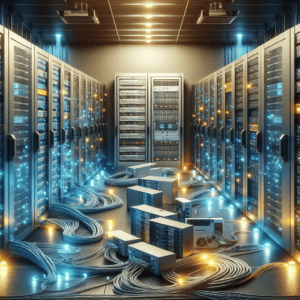Data centre power management is crucial for optimising efficiency and reducing operational costs. At EziBlank, we understand the unique challenges faced by data centre professionals, which is why our innovative solutions, including our industry-leading blanking panels, are designed to enhance air-flow management while cutting down energy consumption. With our quick and easy installation process, you can significantly improve the performance of your infrastructure investment and ensure that your data centre operates at peak efficiency. Explore how EziBlank can empower your power management strategy today!
How Massive Data Centers Power ChatGPT and Google AI
In today's digital era, the sheer scale of data centres is mind-boggling, especially when considering the role they play in powering advanced AI systems like ChatGPT and Google AI. These massive facilities are the backbone of modern technology, ensuring that AI applications run seamlessly by managing and processing vast amounts of data at incredible speeds. As AI continues to evolve, the infrastructure supporting it must be robust, efficient, and sustainable. Understanding the significance of these data centres provides insight into the complex operations that keep our digital world running smoothly.
Read More
What are the different types of data centers?
Data centres are the backbone of modern digital operations, and they come in various forms to meet diverse needs. From enterprise data centres that are privately owned and operated by a single organisation to colocation facilities where multiple businesses share the space, each type is designed to address specific operational requirements. Hyperscale data centres, with their vast capacity, support massive cloud computing needs, while edge data centres bring processing power closer to the source of data generation, reducing latency. Understanding these different types of data centres is essential for businesses looking to optimise their digital infrastructure.
Read More
Why Are Data Centers Important?
In an increasingly connected world, data centres have become the unsung heroes of our digital lives, powering everything from online shopping to streaming services and complex AI operations. These critical facilities store, process, and distribute vast amounts of data, ensuring that businesses and individuals can access the digital tools and information they need in real-time. The importance of data centres extends beyond mere storage; they are integral to the functioning of our digital economy, providing the backbone for everything from everyday internet usage to the advanced computing required for innovation and growth.
Read More
Everything you need to know about data center power
Power is the lifeblood of any data centre, underpinning the operation of servers, cooling systems, and networking equipment. Ensuring a reliable and continuous power supply is critical, as even a brief outage can lead to significant disruptions. Data centres typically rely on a combination of grid electricity, uninterruptible power supplies (UPS), and backup generators to maintain operations during power failures. Power distribution within the facility must be carefully managed to ensure that all equipment receives the necessary voltage and current, while also allowing for redundancy to prevent failures. Additionally, the efficiency of power usage is a key concern, with modern data centres adopting technologies like power usage effectiveness (PUE) metrics to optimise energy consumption and reduce costs. Understanding these aspects of data centre power is essential for maintaining high performance and reliability in a facility.
Read More
Data Center Checklist
A comprehensive data centre checklist is an invaluable tool for ensuring that all critical aspects of data centre management are addressed. This checklist typically covers a wide range of areas, including physical infrastructure, power management, cooling systems, security measures, and network connectivity. Key items might include verifying the integrity of power supply and backup systems, ensuring efficient cooling with proper airflow management and blanking panels, and confirming that all security protocols, such as access controls and surveillance, are in place. Additionally, regular maintenance schedules, disaster recovery plans, and compliance with industry standards should be reviewed and updated. Using a detailed checklist helps data centre managers maintain operational efficiency, minimise downtime, and ensure that the facility is prepared to meet current and future demands.
Read More
